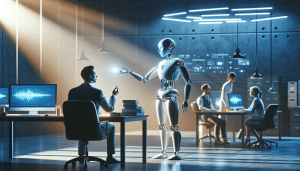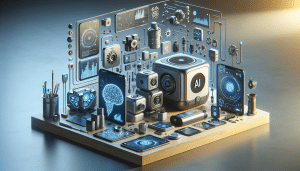Unlocking the Secrets of Artificial Intelligence for Everyday Life
Aiden Foster September 13, 2025
Artificial intelligence now powers more technology than ever before, shaping how people work, learn, and connect. This guide demystifies AI’s rapid growth, showing how machine learning, automation, and smart devices weave quietly into daily routines. Explore core terms, practical impacts, and emerging trends to deepen your understanding of today’s transformative tech.
Understanding Artificial Intelligence Basics
Artificial intelligence, or AI, refers to computer systems capable of tasks that typically require human intelligence. These include recognizing speech, making decisions, or solving problems, all driven by algorithms and vast data sets. While the term may sound futuristic, AI is already embedded in many products and online experiences. For example, digital assistants like Siri and Alexa use AI to interpret voice commands and carry out everyday tasks efficiently (Source: https://www.nsf.gov/news/special_reports/ai/).
The roots of AI date back to early computational theories, but machine learning has sparked recent breakthroughs. Machine learning refers to software that analyzes data to learn patterns and make predictions without explicit instructions. Deep learning, a subset of machine learning, uses artificial neural networks to mimic brain activity, allowing computers to recognize images, languages, and even emotions. These advances are not confined to tech labs—smartphones now use AI for facial recognition and predictive text, making technology more seamless and intuitive.
It’s natural to wonder how AI differs from automation. While automation relates to rule-based execution of repetitive tasks, AI adds a layer of adaptive reasoning and self-improvement. For example, robotic process automation streamlines document filing, but an AI-powered tool could also interpret the document’s meaning and determine filing priorities. Understanding these distinctions lays the foundation for appreciating AI’s broader impact on society and individual routines (Source: https://www.ibm.com/topics/artificial-intelligence).
Machine Learning Applications Transforming Everyday Tasks
Machine learning is quietly influencing many aspects of daily life, sometimes without people realizing it. One example is recommendation systems, which suggest new products, songs, or shows based on past behavior. Streaming services like Netflix and Spotify adapt their recommendations with every selection, improving user experience while demonstrating machine learning in action (Source: https://deepmind.com/blog/article/what-is-machine-learning).
Healthcare is another area rapidly transformed by AI. Algorithms now help radiologists identify anomalies in scans, accelerating diagnosis and improving accuracy. Wearable fitness trackers combine biometric data with AI, supporting healthier lifestyles by interpreting sleep patterns and recommending personalized routines. As a result, people benefit from proactive health insights and early intervention, demonstrating AI’s practical value beyond tech enthusiasts.
For businesses, AI streamlines workflows and enhances decision-making. From virtual customer service agents that resolve queries around the clock to real-time fraud detection in banking systems, AI-driven tools save time and reduce error rates. Automating repetitive tasks frees up human workers for creative problem solving, signaling an evolution in workplace productivity strategies.
Smart Devices and the Internet of Things in Everyday Environments
The Internet of Things (IoT) connects devices, sensors, and appliances so that they communicate and work together. Smart thermostats adjust heating by learning household routines, while home security cameras automatically differentiate between familiar faces and potential intruders. This level of automation, grounded in machine learning, creates environments that prioritize convenience and safety (Source: https://www.nist.gov/topics/internet-things-iot).
Voice-controlled smart home devices make it easier to control lights, music, or schedules with simple commands. By harnessing natural language processing, AI understands requests and context, steadily becoming more accurate with use. This relationship between people and technology demonstrates how AI enriches everyday comfort, blending seamlessly into the background of normal routines.
Even in cities, AI-driven IoT systems optimize energy usage, manage transportation flows, and monitor environmental quality. Smart traffic lights respond dynamically to congestion, while air quality sensors inform public health efforts. These advances illustrate how connected technology, fueled by advanced analytics, is reshaping shared spaces for greater efficiency and sustainability (Source: https://www.energy.gov/articles/five-ways-iot-and-machine-learning-are-making-energy-smart).
Artificial Intelligence and Data Privacy Concerns
With AI collecting and analyzing vast amounts of data, concerns about privacy and ethical use have intensified. Data extracted from devices or digital footprints often fuel personalization, but this can raise questions about consent and secure handling. Regulatory organizations are now establishing guidelines to ensure data is managed responsibly and transparently (Source: https://www.ftc.gov/news-events/topics/privacy-security).
Many people wonder who owns the data generated by smart home systems, wearable health monitors, or even online shopping preferences. It’s vital that organizations inform users about what data is being collected and for what purposes. Informed consent is more than policy—it builds trust as technology becomes more integrated into daily life.
AI’s ability to analyze sensitive data quickly also highlights the need for robust cybersecurity measures. Encryption, anonymization, and regular auditing are key strategies. As AI grows more powerful, industry experts stress the importance of ‘privacy by design,’ embedding data security protocols into every innovation rather than treating them as an afterthought.
Ethical Considerations and Bias in Artificial Intelligence
Ethics in AI encompasses many diverse challenges. One of the most discussed is bias: if algorithms are trained on incomplete or prejudiced data, they may reinforce unfair outcomes. For example, facial recognition accuracy varies among demographic groups, and recruitment algorithms might favor or disadvantage certain candidates based on training datasets (Source: https://www.brookings.edu/articles/algorithmic-bias-detection-and-mitigation-best-practices-and-policies-to-reduce-consumer-harms/).
Responsible AI design includes ongoing evaluation for unintended side effects or embedded biases. International organizations are calling for transparent AI development practices and regular algorithm audits. Open discussions among technologists, policymakers, and communities foster awareness and drive improvement in fairness and accountability standards.
AI also prompts reflection on human values—what role should machines play in important decisions? Ensuring human oversight in high-stakes applications, such as healthcare or justice systems, is a top priority. Realizing equitable benefits from AI calls for diverse input, vigilance, and continuous learning throughout algorithm development and deployment.
Emerging Trends in Artificial Intelligence Research
AI research is expanding rapidly, branching into fields like computer vision, natural language processing, and robotics. Adaptive learning models, for instance, can now self-improve as they encounter new data. In language, AI-powered translation tools are breaking down global communication barriers, while conversational AI is enabling more natural interactions between humans and machines (Source: https://ai.google/research/).
Collaborative robots, or cobots, are designed to work alongside humans in manufacturing, logistics, and even healthcare. These smart machines enhance productivity by handling dangerous tasks and allowing for more ergonomic and safe human labor. At the same time, generative AI systems can create realistic images, audio, and writing, illustrating both exciting creative opportunities and new ethical questions.
One captivating trend is explainable AI: algorithms are being designed to reveal how they make decisions, helping build user confidence and regulatory trust. With AI woven tightly into daily life, seeing how these systems reach conclusions fosters transparency and furthers ethical use. As research continues, expect even more AI capabilities to surface, shifting what’s possible across industries and routines.
References
1. National Science Foundation. (n.d.). Artificial Intelligence. Retrieved from https://www.nsf.gov/news/special_reports/ai/
2. IBM. (n.d.). What is artificial intelligence (AI)? Retrieved from https://www.ibm.com/topics/artificial-intelligence
3. DeepMind. (n.d.). What is machine learning? Retrieved from https://deepmind.com/blog/article/what-is-machine-learning
4. National Institute of Standards and Technology. (n.d.). Internet of Things (IoT). Retrieved from https://www.nist.gov/topics/internet-things-iot
5. Brookings Institution. (2021). Algorithmic bias detection and mitigation: Best practices and policies to reduce consumer harms. Retrieved from https://www.brookings.edu/articles/algorithmic-bias-detection-and-mitigation-best-practices-and-policies-to-reduce-consumer-harms/
6. Google AI. (n.d.). Research. Retrieved from https://ai.google/research/








